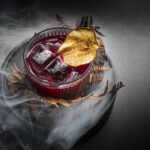Recently, John Eric Home had the opportunity to sit down with Nicholas Ferguson of The Colour of Splash to discuss his career, his works, and the world of art.
JEH: Let’s start at the beginning of your journey. What was the catalyst, that moment that made you pursue art (either personally or professionally or both)?
NF: This is a good question. I have a brother who’s two and a half years younger than me, and we used to spend a lot of time drawing as children as a form of entertainment. We’d take the old typewriter paper that was attached sheet by sheet and create comics that would just keep on going, with crazy storylines that included battlefields, royalty, and walking and talking animals. We were very imaginative, and it was fun – it was a form of play, with the odd argument for good measure! It was also a form of expression. As is so common these days, we had separated parents and there was friction from that. From a personal perspective, I used art as a means of escapism.
In terms of pursuing art professionally – there’s a side of me that has always wondered where I would have been now had I attended art school. As it turns out I studied hospitality and then went on to a career in marketing. Both hospitality and marketing revolve around people and inviting people into worlds – so all was certainly not lost as there are clear parallels with the arts. While in the aforementioned worlds, I continued working on my art – exploring mediums and techniques – from sculpture, to architecture, fashion design, and even improv. During COVID I started to question my future exclusively as a marketer. At the same time, I began to gain traction with my art. I had two pieces accepted into an exhibition and one of them (Fruhstuck – see details later) won an award. It was a case of following the breadcrumbs. Today, I’m a professional artist, and I am also expanding other parts of my business.
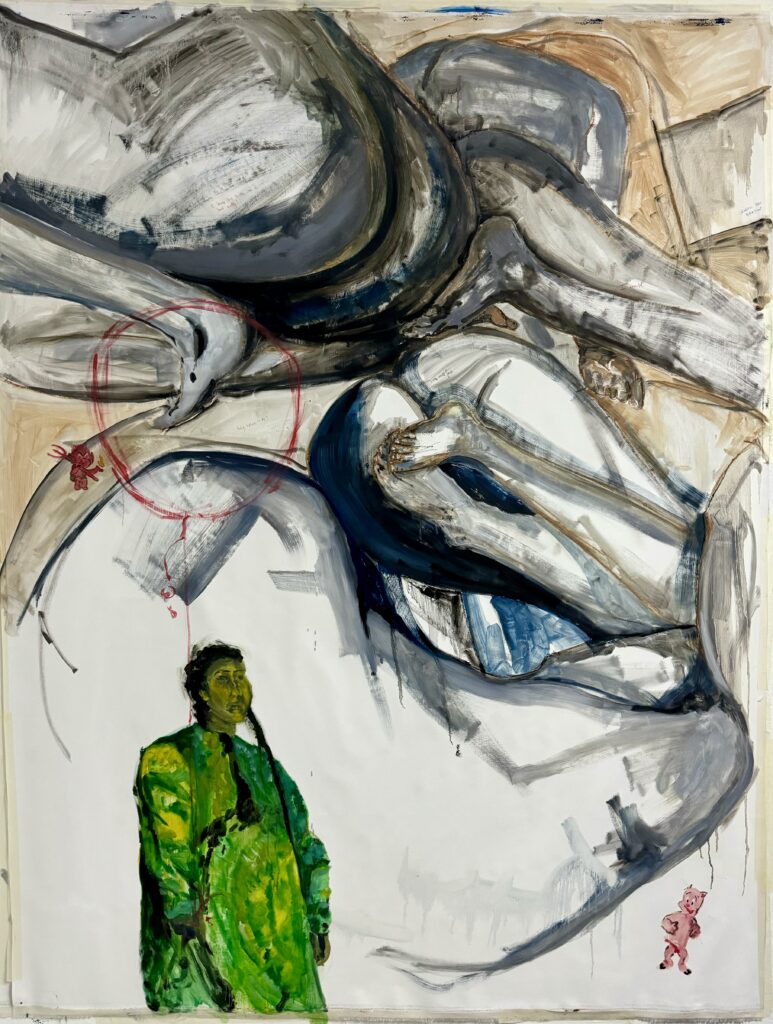
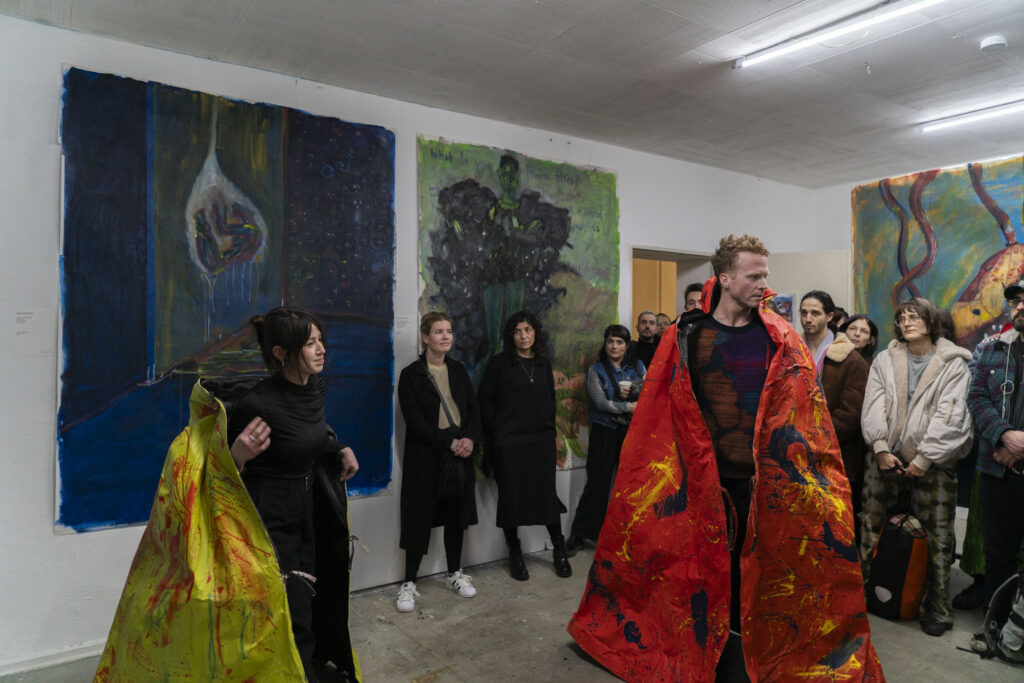
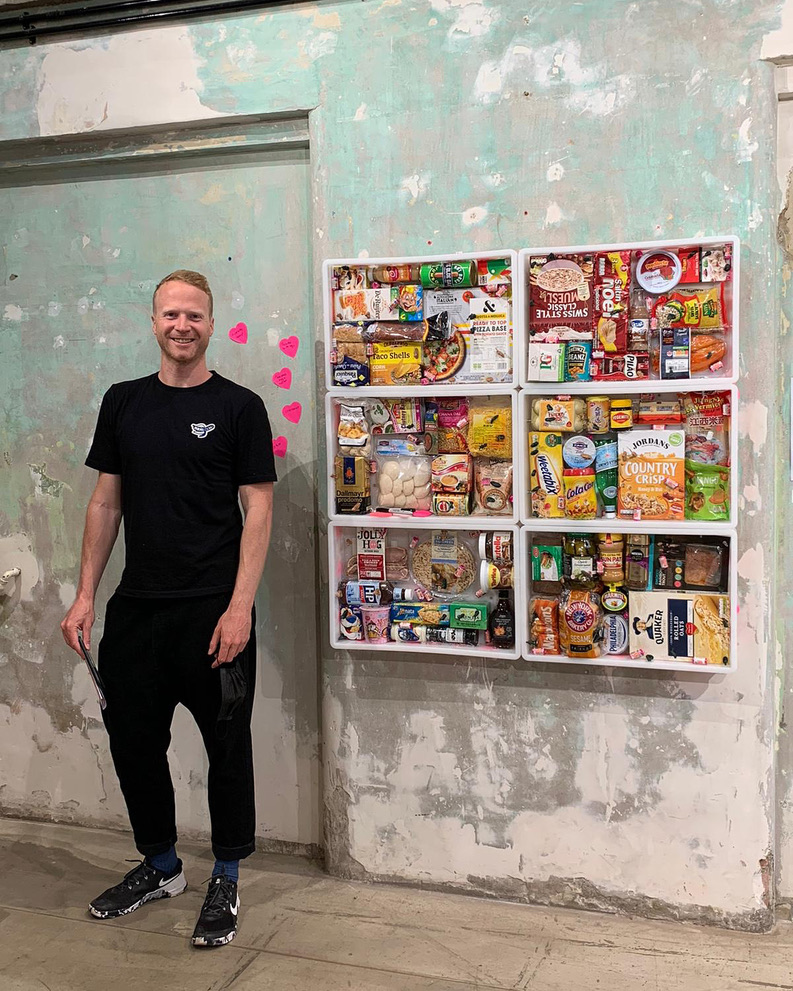
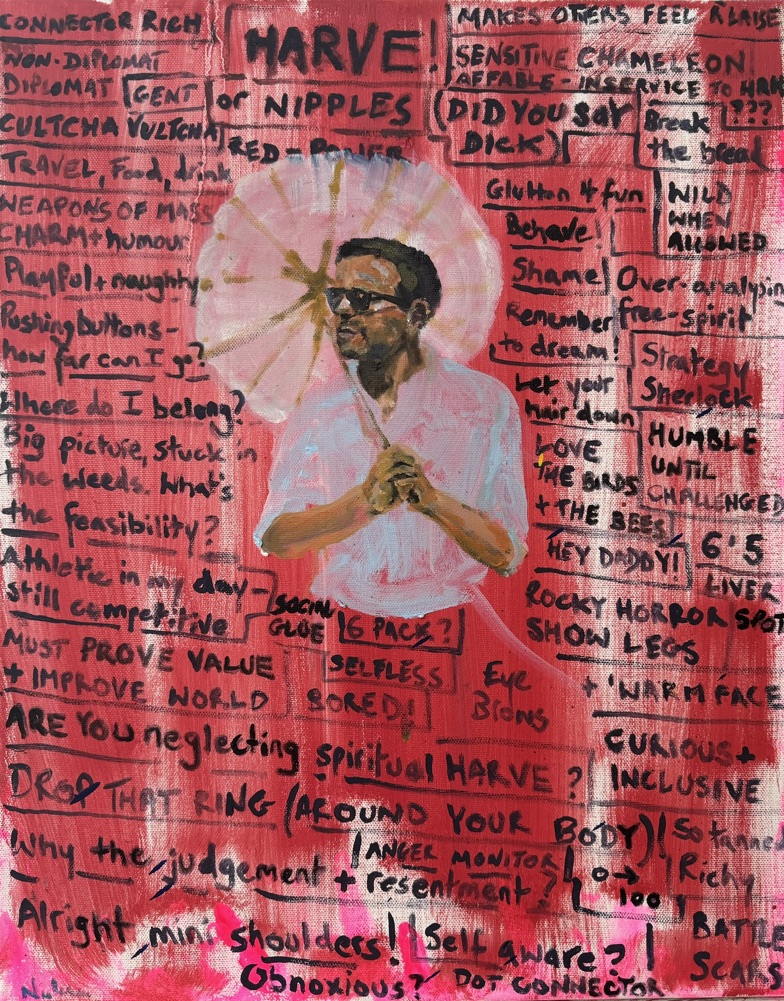
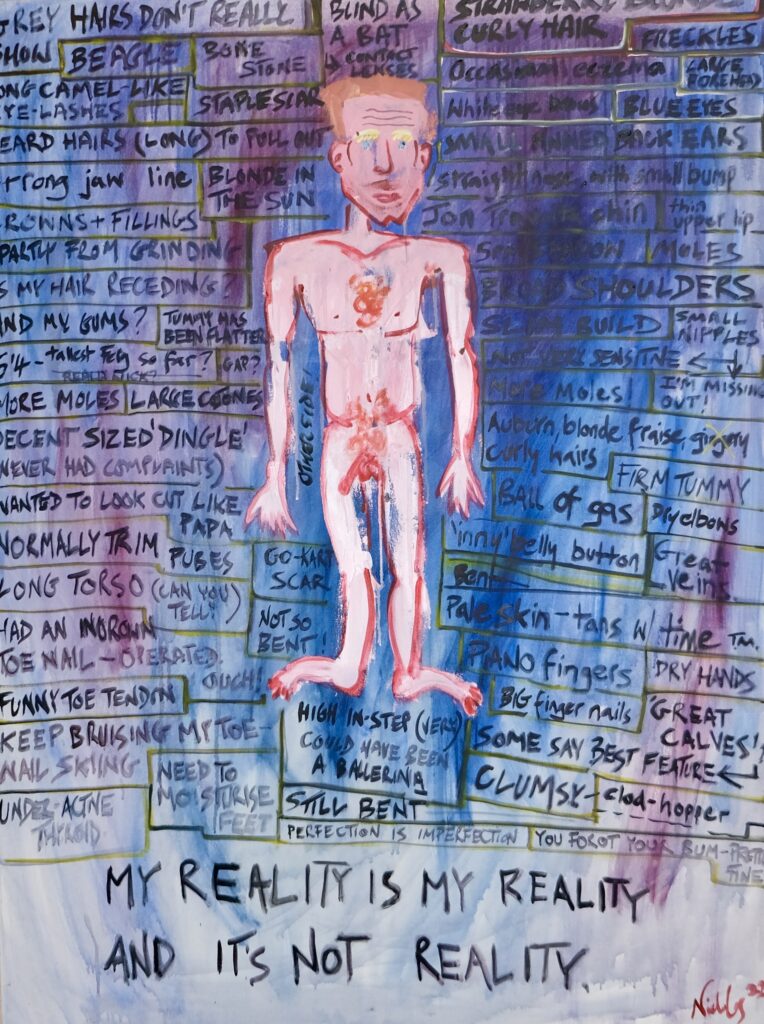
JEH: What inspires you to paint and create?
NF: I’m a curious type – I’m inspired by my peculiarities, my identity and by what I see around me – in other people and in broader society. I love meeting new people and engaging in deep philosophical conversations. I explore my thoughts around these topics in my artwork. It’s my way of making sense of my world, I guess. The pieces speak to where I am in my life at a given point in time. They often have a spiritual undercurrent – they flow through me. I like to bring playfulness and humor into what I create, and I like people to walk away thinking or feeling something different from before they saw my work – but that’s rarely at the forefront as I start painting. It comes later in the process.
JEH: What inspires you to paint a particular piece?
NF: When I come to working on a new body of work, I have a practice – almost like a form of meditation, where I’ll connect with the theme of the work and its qualities, including the medium and emotions I want to evoke. For example, when I was in Berlin earlier in the year, I started with a loose theme of “dreams”, which then morphed into “the dance of hide and seek” and my relationship to following the desires of my heart. When it comes to the individual works, I’ll get a name or concept for them from the theme which I’ll typically sketch out roughly on paper. It will often consist of notes, rather than images. And from there I start painting. I generally work on more than one piece at a time.
JEH: Are there any movements or styles or artists that have and/or continue to impact your work?
NF: There are certainly artists that have inspired me and for different reasons, some stylistically, some for their messages.
I was drawn to Francis Bacon when I was much younger. I still am drawn to his work for his ability to capture movement in paint, but also for his exploration of the human shadow and sexuality. I was a big fan of Lucian Freud as well, who again was an amazing realist painter; I think some of his technique comes through subconsciously when I paint figures.
More recently I admire the work of Basquiat and Warhol. Warhol, because he brought elements from his world of advertising into his work, questioning the very nature of art. Advertising is after all intended to inspire you to buy a product. Whether you buy my product or not, I’m trying to get you to ‘buy into’ my perspective and what I feel or see as an artist. Basquiat on the other hand was revolutionary for his time. He was a street artist, sure, but he was also exploring what it meant to be a black man in a very white Western art world, bringing in elements of philosophy and African spirituality and mixing them with inspiration from the world he inhabited. He was pushing boundaries. I also appreciate Philip Guston’s work for his use of color, his exploration of spirituality, and his rebellious nature.
Away from painting – I recently saw Marina Abramovic’s retrospective in London, and what I admire about her is how she removes the ego – she’s a vessel for whatever she needs to express – even if it has the potential to physically harm herself in the process. I also collect and admire what I guess you might call indigenous or tribal art – for its abstractness and spirit. I could go on…!
I’m sure all these styles and artists have had an impact on my work subconsciously, but I don’t focus on them as I paint.
JEH: Where has your journey, thus far, taken you?
NF: In a literal sense – my journey started in Lausanne, Switzerland where I was born. I moved to London as I was drawn to its cosmopolitan nature and the creative buzz of the city. This is where I started my artistic career too.
I’m speaking to you from Berlin though, where I spent the first 3 months of this year at an art residency. That was a special time – being surrounded by other artists nearby from all around the world in the depths of the Berlin winter. It brought us together to create a very special bond and our work took on flavors from each other through a sort of osmosis, without necessarily seeing or discussing the work. Off the back of that experience, I was accepted to a show as part of a group exhibition at the Ballery, a multi-disciplinary space in Berlin – hence my return to this city now.
From here on, I can see myself spending time in other parts of the world, as I continue to explore my practice.
JEH: Can you speak on the different mediums that you incorporate in your works?
NF: I’m primarily a storyteller, so I tell stories through my art. I use different mediums depending on what I decide to tell in that story. My primary medium is oil painted on canvas accompanied by poetry. I also use pastels and collages and have ventured into 3D, with wearable paintings and music, in collaboration with other artists. When I’m responsible for the total experience, I like to bring people into a world that combines mediums,
JEH: Can you please speak on your different collections – both past and present?
NF: My most recent collection is called “Les debutants” and currently consists of just one painting. It speaks to the privilege of the beginner’s mindset as an opportunity to innovate and break boundaries. I painted it with my left hand, which was challenging as I’m right-handed and forced me to adopt the beginner’s mind. I haven’t decided yet whether this piece will be joined by others. I’ll decide when I get back to my studio.
In terms of previous collections – I showed a collection of works entitled “Perspective” at my first solo exhibition in Fitzrovia, London, last summer. These were very colorful pieces with characters from pop culture like Homer Simpson, the ‘Toilet Duck’ duck, and controversial figures like Hitler and Donald Trump. The main theme speaks to how our perspective is constantly shaping our definition of reality – which we then live into – and questions certain ideals in Western culture through this lens.
In Berlin, I created a body of work entitled “the dance of hide and seek” which incorporated six paintings, two wearable paintings, and a soundtrack. This theme speaks to the relationship between the heart and the mind, the cost of not expressing the desires of the heart, and the fears and vulnerability that can accompany the expression. The style of the pieces was quite varied as my process is always very intuitive, though there’s a definite vibe to them; they’re quite somber, which I think reflects the time of year and what I was going through in Berlin.
JEH: Can you please speak on your experience as a portraiture artist?
NF: I’d say I started my art career as a portrait artist. I enjoy painting people and getting to know them. There’s never a shortage of people to paint either from photos or from life. In my early years, I’d paint somebody simply because I found them interesting. Now I will include people in my collections if I get that it’s true to do so – I tend to work more from my imagination, than from life.
I do however offer commissioned portraits – and these came from the seed of a self-portrait that I created in 2022, entitled ‘self-reflective portrait’. In the self-portrait, I painted a cartoon-like naked figure of me surrounded by all the things I like and dislike primarily about my body. It was a very cathartic exercise and I felt quite vulnerable exposing my thoughts in such a way – but I’m over it now! I used the tagline “my reality is my reality and it’s not reality” to speak to this idea that only I see the full extent of my foibles.
I now offer a version of this to clients which has had considerable success. The process starts with me channeling the person, a bit like a medium would. I’m able to put myself in a state where I receive information about the client in their greatness (think of this as their talents) and in their ego (you can think of this as their weaknesses). The fact is we all have God-given talents and often, our worst enemy is the owner of those talents. These paintings, which incorporate a portrait of the person and words from the reading, act as a means of reminding the client of who they are in their greatness and reminding them to shift focus when they find themselves in their ‘shit’.
JEH: Can you describe for our readers the differences between painting a fresh canvas out of inspiration and a commissioned (or non-commissioned) portrait?
NF: When I’m working towards a collection, the only boundary is the theme and even that is quite malleable. For example, I had a collection centered around the theme of “home” in 2022, which included my self-reflective portrait, an imaginary takeover of Mars, and a homeless lady sleeping under a tree in a park near where I live.
When I’m working on a portrait – the boundary is the client. I will make use of any information that I get about the client that I feel will serve them, but there’s a definite boundary. I only show the work to the client when it’s complete as it helps my creative process to maintain that tension until the great reveal. So far, they’ve all loved them as they’re such personal pieces.
JEH: Can you describe what it’s like to prepare for and mount an exhibition?
NF: I did this for my first solo exhibition last summer. It’s when the theme really starts to come into its own – everything was considered, from the choice of food and drinks to the music, the invitations, and the invitees. It’s a lot of work and great fun. I drew up a plan a couple of months in advance and worked backward from my desired outcomes. Once the plan was written down, it’s amazing how things started to come together – finding people to help me with merchandise and friends who could assist with introductions for food and the all-important hanging of the work. I’m about to curate and hang my 4th exhibition in June in London, which will be a group show, and I’m excited to bring all the artists and their work together. The best feeling comes after the show is over and I can reflect and relax before starting on the next collection.
JEH: Can you please share one or two cool or fun or unique anecdotes from either your personal or professional life as an artist?
NF: Yeah, there are a couple. The first was in the preparation for “les debutants” here in Berlin. I managed to lock myself out of my studio and when I got back in, I had a very short deadline to finish and dry the painting before flying to Berlin. I had to spend an evening with two fans blowing air at the painting and it was still slightly wet on the day of travel, so I had to come up with a quick way of protecting it while in transit: tracing paper!
The other funny anecdote relates to “Fruhstuck” – which means breakfast in German – and is the first piece I mentioned in my journey to becoming a professional artist, which won an award. It was a sculpture containing real breakfast items and I made it in 2020, only for the exhibition to be delayed until 2021 due to COVID. I kept it in my room as it was huge and I would walk around my flat wondering where the farty smell was coming from, only to remember it was coming from Fruhstuck. Remarkably, I only had to replace one item – the English kippers (a type of smoked fish popular for breakfast in the UK). Shockingly a lot of the food looked no different from a year earlier – e.g. pain au chocolat – which has its own implications for what we put into our bodies.
JEH: Can you please tell us about The Colour of Splash?
NF: Yes, of course. The Colour of Splash has been brewing for a while – nearly 20 years to be precise. I created it as a general name for my art portfolio and it has since become a name for my practice. That’s all about to change though, as I will be splitting it from my artistic practice (l’atelier artistik NAF) and it will become a place for collaboration among creatives, a dedication to soulful expression, and a platform for encouraging others to express themselves creatively through events, workshops, and coaching. It is a work in progress – and there’s lots more to come!
JEH: What motivated you to create the platform?
NF: I enjoy working with others – I love collaborating. It makes for a more fulfilling experience in my opinion. I also have had my regrets about not pursuing an artistic career at an earlier age – and so The Colour of Splash is my way of encouraging others to take a creative jump, wherever they are, in whatever way that looks like – now! I also support a charity that helps mentor young people in the creative field for the same reason.


